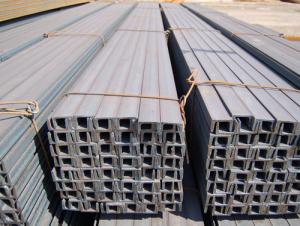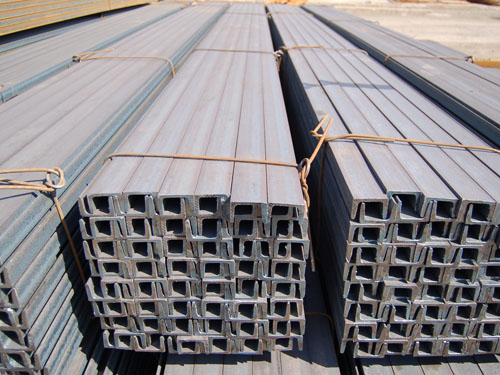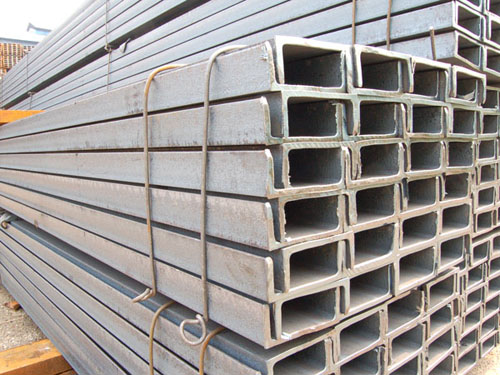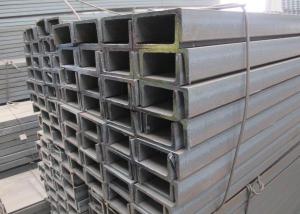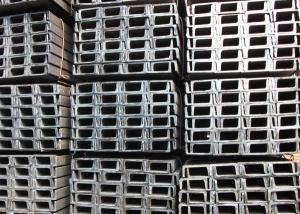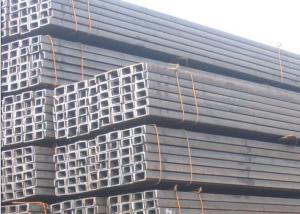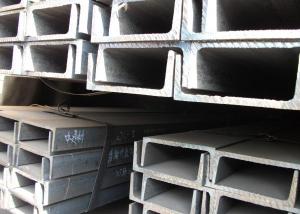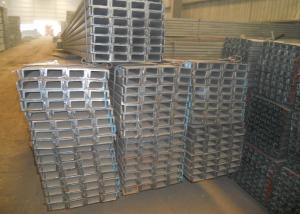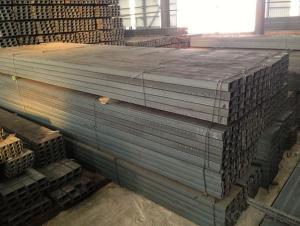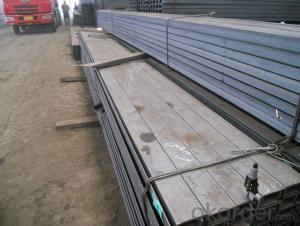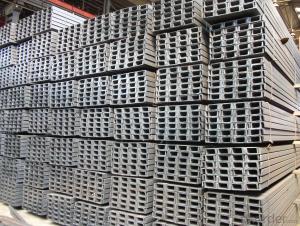UPN U CHANNEL
- Loading Port:
- China Main Port
- Payment Terms:
- TT OR LC
- Min Order Qty:
- -
- Supply Capability:
- -
OKorder Service Pledge
OKorder Financial Service
You Might Also Like
Channel Steel Details:
| Minimum Order Quantity: | 25 | Unit: | m.t. | Loading Port: | Xingang Port |
| Supply Ability: | 80000MTS/YEAR | Payment Terms: | TT or LC |
Product Description:
Specifications of Channel Steel:
| Original Place | Tangshan, China | Brand Name | Bridge |
| Standard | GB707-88, EN100025, JIS G3192, DIN 1026 | ||
| Sizes | 50mm to 300mm | ||
| Sales Volume/Year | 3000MT | ||
| Main Market | Middle East, Africa, Southeast As | ||
1.We are able to provide channel steel of top quality at attractive price.
2.Our products of channel steel have passed ISO9001:2008 Quality Management System Certification.
3. The section of JIS Standard Channel Steel are as followings in the table.
| JIS U CHANNEL | Standard h | Sectional b | Dimension s | t | Mass: Kg/m |
| (mm) | (mm) | (mm) | (mm) | ||
| 50x25 | 50 | 25 | 3.0 | 6.00 | 2.37 |
| 75X40 | 75 | 40 | 3.8 | 7.00 | 5.30 |
| 75X40 | 75 | 40 | 4.0 | 7.00 | 5.60 |
| 75X40 | 75 | 40 | 4.5 | 7.00 | 5.85 |
| 75X40 | 75 | 40 | 5.0 | 7.00 | 6.92 |
| 100X50 | 100 | 50 | 3.8 | 6.00 | 7.30 |
| 100X50 | 100 | 50 | 4.2 | 6.00 | 8.03 |
| 100X50 | 100 | 50 | 4.5 | 7.50 | 8.97 |
| 100X50 | 100 | 50 | 5.0 | 7.50 | 9.36 |
| 125X65 | 125 | 65 | 5.2 | 6.80 | 11.66 |
| 125X65 | 125 | 65 | 5.3 | 6.80 | 12.17 |
| 125X65 | 125 | 65 | 5.5 | 8.00 | 12.91 |
| 125X65 | 125 | 65 | 6.0 | 8.00 | 13.40 |
| 150x75 | 150 | 75 | 5.5 | 7.30 | 14.66 |
| 150x75 | 150 | 75 | 5.7 | 10.00 | 16.71 |
| 150x75 | 150 | 75 | 6.0 | 10.00 | 17.90 |
| 150x75 | 150 | 75 | 6.5 | 10.00 | 18.60 |
4. Chemical Compostion of JIS Standard Channel Steel
| Grade | Element(%) | |||
| C | Mn | P | S | |
| SS330 | -- | -- | ≦0.050 | ≦0.050 |
| SS400 | ||||
| SS490 | ||||
| SS540 | ≦0.30 | ≦1.60 | ≦0.040 | ≦0.040 |
Usage/Applications of Channel Steel:
Channel Steel is usually used for building structure, vehicle manufacturing and other industrial structure and often used with i beam.
In details, the channel steel belongs to carbon structural steel which is applied to in the field of construction and machinery. The channel steel is usually used for arch-itechtural structure, and they could be welded in order to support or hang a vari-ety of facilities. They are also usually used in combination with I beam. Generally,the channel steel must possess perfect welding property, riveting property and mechanical property and so on.
Package & Delivery of Channel Steel:
The steel u channel will be packed in bundle with steel wire at each end of every bundle and color marking in order to help the customer to recognize his goods more easily at sight.
And steel u channel could be loaded into 20ft or 40ft container, or by bulk cargo. If the weight of each bundle reaches less than 3.5 mt, the loading by break bulk cargo should be choosed. When the weight of each bundle reaches less than 3mt, the loading by container should be choosed.
As for the transportaion from mill to loading port, the truck will be usually used. And the maximum quantity for each truck is 40mt.
All in all, we could do in accordance with customer's request.
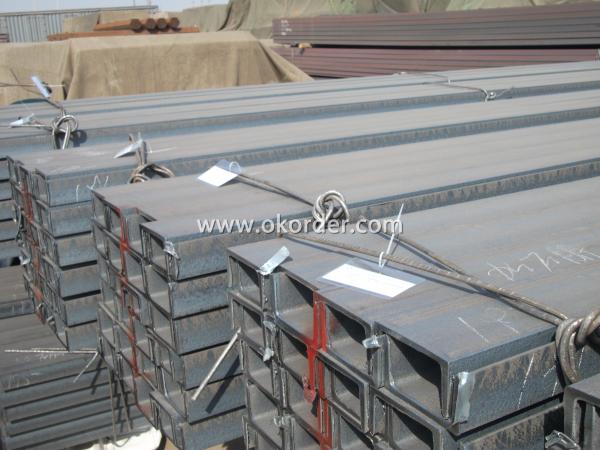
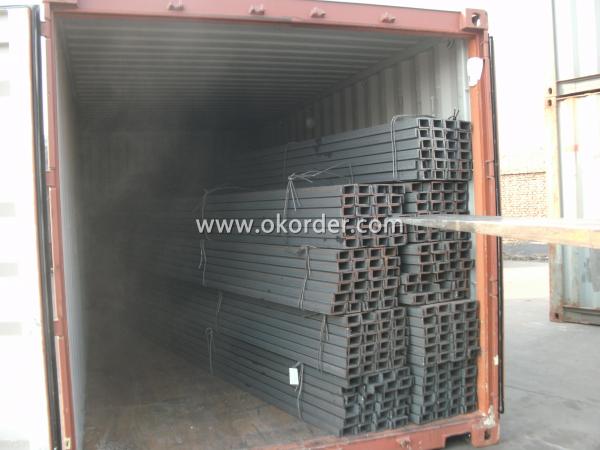
Production Flow of Channel Steel:
1.The steel billet shall be heated in the high temperature furnace.
2. The heated steel billet shall be rolled five to nine times with the aim of shaping the general figure of steel u channel.
3. The rolled steel u channel should be put onto the cooling bed to make the temperature low.
4. The steel u channel should be straighted on the straightener.
5. The straighted steel u channel will be cut into meters by saw, as per customer's requirements.
- Q: The telescopic arm is welded by channel steel and steel plate. Then the channel steel is inclined and the guide is not good enough. Is it a special profile? What are the telescopic arms?
- You think, is certainly the square and thick wall, to ensure the overall stiffness and strength.When the channel steel is welded together, how can the weld be treated? If the welded joint is too high, it will affect the expansion of the inner and outer walls Flat and can not, and it can not be welded inside, how to ensure that the intensity?In order to save money by not crane factory this rough steel welding method, and crane safety first, but once the problem is not trivial, does not rule out a small factory dare to do so, but definitely not the formal business.This kind of profile is formed at one time without any subsequent welding. It is a pressing forming sleeve with cold drawing technology!
- Q: How are steel channels used in the construction of hospitals or healthcare facilities?
- Steel channels are used in the construction of hospitals or healthcare facilities to provide structural support and reinforcement. They are commonly used in the framing of walls, ceilings, and floors, ensuring the stability and durability of the building. Steel channels also play a vital role in the installation of electrical and plumbing systems, as they provide a secure pathway for wiring and piping. Additionally, they are utilized for mounting equipment, such as medical gas lines or HVAC units, ensuring efficient operation and maintenance of the facility.
- Q: Large steel channel used for steel structural staircases
- Standard Specification for channel steel is C250*78*6TThe rest are flat steel strips and checkered steel plates
- Q: Are steel channels suitable for solar panel installations?
- Yes, steel channels are suitable for solar panel installations. Steel channels, also known as steel C-channels or U-channels, are commonly used as mounting structures for solar panels. They provide a strong and durable support system for the panels, ensuring their stability and longevity. Steel channels are preferred for solar panel installations due to their high strength-to-weight ratio, making them capable of withstanding various environmental conditions. They offer excellent resistance to corrosion, which is crucial for outdoor installations exposed to rain, snow, and humidity. Additionally, steel channels can be customized and fabricated to fit specific solar panel dimensions, allowing for easy and secure attachment. Moreover, steel channels are cost-effective compared to other mounting options, such as aluminum or stainless steel. They are readily available in the market and can be easily installed by professionals. The versatility of steel channels also makes them suitable for both ground-mounted and rooftop solar panel installations. In conclusion, steel channels are a reliable and suitable choice for solar panel installations. Their strength, durability, resistance to corrosion, cost-effectiveness, and ease of installation make them an ideal choice for supporting solar panels and ensuring their optimal performance.
- Q: How do steel channels contribute to the overall sustainability of a solar power plant?
- Steel channels contribute to the overall sustainability of a solar power plant in several ways. Firstly, steel channels are used in the construction of the solar panel mounting system. These mounting systems are essential for securing the solar panels in place and ensuring optimal sun exposure. By using steel channels, which are durable and long-lasting, the mounting system can withstand various weather conditions and remain intact for a longer period of time. This reduces the need for frequent maintenance and replacement, thereby reducing the environmental impact associated with the production and disposal of materials. Moreover, steel channels provide structural support to the solar panels, ensuring their stability and longevity. This is particularly important in regions prone to high winds, storms, and seismic activities. By using steel channels, the solar power plant can withstand these natural events and continue to generate clean energy without interruption. This resilience reduces the risk of damage or downtime, resulting in a more reliable and sustainable energy source. Additionally, steel channels can be made from recycled steel, which further enhances the sustainability of a solar power plant. Using recycled steel reduces the demand for virgin steel production, which is an energy-intensive process with significant carbon emissions. By opting for recycled steel channels, the solar power plant can minimize its carbon footprint and conserve natural resources. Furthermore, steel channels can be designed in a way that facilitates easy installation and maintenance of the solar panels. This not only reduces the labor and time required for installation but also allows for efficient cleaning and upkeep of the panels. Regular cleaning of solar panels is essential to maximize their energy generation capacity. By utilizing steel channels that enable easy access to the panels, the plant can ensure optimal cleanliness and efficiency, ultimately contributing to the overall sustainability of the solar power plant. In conclusion, steel channels play a crucial role in enhancing the overall sustainability of a solar power plant. They provide durability and stability to the solar panel mounting system, reducing the need for frequent maintenance and replacement. Their use of recycled steel helps minimize the environmental impact associated with steel production. Additionally, steel channels facilitate easy installation, maintenance, and cleaning of the solar panels, ensuring their optimal performance and efficiency. With these contributions, steel channels significantly contribute to the long-term sustainability and viability of a solar power plant.
- Q: Can steel channels be used in railway and transportation infrastructure?
- Yes, steel channels can be used in railway and transportation infrastructure. Steel channels are commonly used in the construction of railway tracks, bridges, and other transportation structures due to their high strength and durability. They provide necessary support and stability to the infrastructure, ensuring safe and efficient transportation operations.
- Q: What are the types of channel steels?
- Channel steel is divided into ordinary channel steel and light channel steel. Standard Specification for hot-rolled plain channel steel is 5-40#. Specifications for hot rolled flexible channel steel supplied by supply and demand agreement are 6.5-30#. Channel steel is mainly used in building structures, vehicle manufacturing and other industrial structures, and channel steel is often used in conjunction with i-beam.
- Q: 12# how much is a channel steel? The length is 6 meters. GB steel channel should be used
- Channel steel is a kind of carbon structural steel used for construction and machinery. It is a complex section steel. Its cross section has a groove shape. Channel steel is mainly used in building structure, curtain wall engineering, mechanical equipment and vehicle manufacturing, etc..
- Q: Do steel channels have any specific thermal expansion properties?
- Yes, steel channels do have specific thermal expansion properties. Like all materials, steel expands and contracts with changes in temperature. The thermal expansion of steel channels is primarily determined by the coefficient of linear expansion, which is a measure of how much the material expands per unit length per degree Celsius (or per unit length per degree Fahrenheit). The coefficient of linear expansion for steel typically ranges between 10 to 13 parts per million per degree Celsius (10-13 ppm/°C). This means that for every degree Celsius increase in temperature, a steel channel will expand by approximately 10 to 13 parts in a million of its original length. It is important to consider the thermal expansion of steel channels in various applications to ensure proper design and functionality. For example, in structures where steel channels are used, such as bridges or buildings, allowance must be made for the expansion and contraction of the channels to prevent stress buildup and potential damage. Expansion joints or other methods of accommodating thermal expansion are typically incorporated into the design to account for these properties. In summary, steel channels do exhibit specific thermal expansion properties, which are determined by the coefficient of linear expansion. Understanding and accounting for these properties is crucial in the design and application of steel channels to ensure their structural integrity and functionality in varying temperature conditions.
- Q: Can steel channels be customized according to specific requirements?
- Yes, steel channels can be customized according to specific requirements. Manufacturers can tailor the dimensions, lengths, thicknesses, and finishes of steel channels to meet the specific needs and preferences of customers.
Send your message to us
UPN U CHANNEL
- Loading Port:
- China Main Port
- Payment Terms:
- TT OR LC
- Min Order Qty:
- -
- Supply Capability:
- -
OKorder Service Pledge
OKorder Financial Service
Similar products
Hot products
Hot Searches
Related keywords
